Woodthorpe St MarkFeatures and Fittings
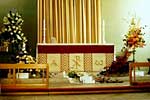 The altar frontal in 1979 The altar frontal in 1979 |
In the sanctuary a wooden cross hangs in front of a coloured dossal (renewed in 1972) over a plain oak altar, for which a coloured frontal was provided. The frontal included the traditional 'X P' sign, being the Greek letters 'Chi Rho', the initial letters of the name 'CHRIST' in Greek; this sign was worn by the soldiers in Constantine’s army on their helmets, following the Emperor’s conversion to Christianity and have since been frequently found in Christian symbolism. The same letters are used on the silver processional cross.
Also on the frontal were incorporated the letters Alpha and Omega, the first and last letters of the Greek alphabet, from the quotation in the Book of Revelation: 'I am the Alpha and the Omega, the beginning and the end', says the Lord God.’ The embroidery on the frontals was carried out by a member of the church.
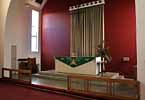 The sanctuary The sanctuary |
 The chancel The chancel |
The original frontals were replaced in 2001, as a result of a millennium project. The inscriptions were retained in the new design.
The altar stands out from the wall, this arrangement allows the celebrant to face the congregation.
Ornaments, furniture and vessels were provided by members and friends of the church.
The original furnishings in the chancel included oak pews and stalls for the choir and oak prayer desks for the clergy, leaving an open area in the middle to give an uninterrupted view of the sanctuary. Subsequently the choir stalls and pews were removed and the chancel area carpeted with a red colour to tone with the liturgical east wall.
 Mural showing the Mural showing the
visitation of the Magi |
 Nave looking Nave looking
liturgical east |
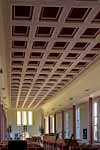 Nave ceiling Nave ceiling |
A mural sculpted in a fired clay mosaic pattern, depicting the visitation of the Magi, and which had formerly hung in the children’s corner was re-sited on the wall of the sanctuary beneath the organ loft.
In the nave much of the richness and colour of the church is due to the fibrous plaster coffered ceiling and columns, which have been decorated in striking colours. The ceiling panels, originally coloured green, magnolia, brown, magnolia, and blue in the nave, lead the eye on to the liturgical east end where gold leaf was used in the decoration of the panels.
The steel framework of the building forms the core of the columns, which originally were coloured green and magnolia.
Following re-ordering in 1987 the green in the columns was replaced by a deep red colour to match the liturgical east wall. The ceiling panels throughout the nave and chancel and sanctuary were changed to red, magnolia and red.
Also during the 1987 re-ordering the first six rows of seating were removed in order to accommodate a semi-circular wooden dais. The latter which abutted the chancel step was covered with a red patterned carpet. A removable altar rail, arranged in sections, allowed the use of a table on the dais from which Holy Communion could be celebrated.
The original seating was provided by 350 oak chairs with grey vinyl seats. The chairs were replaced in 2010 with 150 light oak chairs with armrests and upholstered seats.
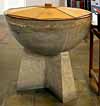 Font Font |
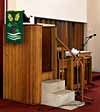 Pulpit Pulpit |
The liturgical west end of the church is dominated by the plain stone font, bowl-shaped on three sturdy legs. It stands in the centre aisle directly in line with the main altar.
The pulpit and lectern were of panelled oak. Subsequently the lectern was removed to provide space for a music group. A portable lectern, in light oak now stands at the front of the dais. A sound console has been installed in front of and to the left of the font, when looking liturgically eastward. Its function is to coordinate sound from microphones used by the music group as well as those associated with the pulpit and lectern. Audio visual presentations are facilitated by a large screen located on a boom attached to the chancel wall. The boom can be swung so that in use the screen is visible to the congregation
At the base of the bell tower is a children’s’ corner which is now screened from the nave by a pair of glass doors. From 1975 it housed the mural, now in the chancel. It was removed in 2001 when a new damp course was inserted in the nave walls.
At the rear of the nave, to the right of the entrance is a coffee bar installed in 1999. It is screened off during services and is designed to provide refreshments without the need to transfer the congregation to the Church Hall.
|